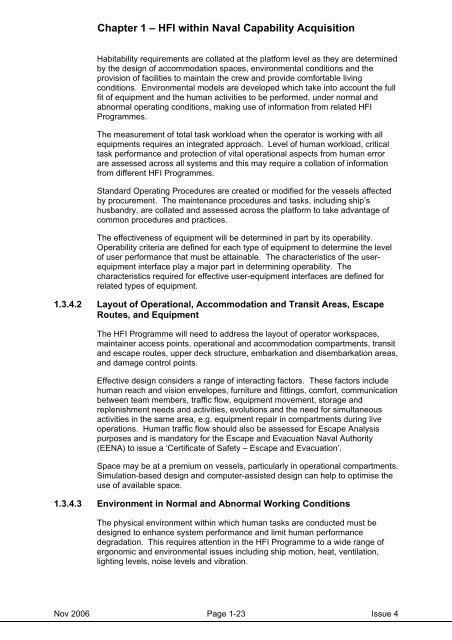MAP-01-010 HFI Management Guide - Human Factors Integration ...
MAP-01-010 HFI Management Guide - Human Factors Integration ...
MAP-01-010 HFI Management Guide - Human Factors Integration ...
Create successful ePaper yourself
Turn your PDF publications into a flip-book with our unique Google optimized e-Paper software.
Chapter 1 – <strong>HFI</strong> within Naval Capability Acquisition<br />
Habitability requirements are collated at the platform level as they are determined<br />
by the design of accommodation spaces, environmental conditions and the<br />
provision of facilities to maintain the crew and provide comfortable living<br />
conditions. Environmental models are developed which take into account the full<br />
fit of equipment and the human activities to be performed, under normal and<br />
abnormal operating conditions, making use of information from related <strong>HFI</strong><br />
Programmes.<br />
The measurement of total task workload when the operator is working with all<br />
equipments requires an integrated approach. Level of human workload, critical<br />
task performance and protection of vital operational aspects from human error<br />
are assessed across all systems and this may require a collation of information<br />
from different <strong>HFI</strong> Programmes.<br />
Standard Operating Procedures are created or modified for the vessels affected<br />
by procurement. The maintenance procedures and tasks, including ship’s<br />
husbandry, are collated and assessed across the platform to take advantage of<br />
common procedures and practices.<br />
The effectiveness of equipment will be determined in part by its operability.<br />
Operability criteria are defined for each type of equipment to determine the level<br />
of user performance that must be attainable. The characteristics of the userequipment<br />
interface play a major part in determining operability. The<br />
characteristics required for effective user-equipment interfaces are defined for<br />
related types of equipment.<br />
1.3.4.2 Layout of Operational, Accommodation and Transit Areas, Escape<br />
Routes, and Equipment<br />
The <strong>HFI</strong> Programme will need to address the layout of operator workspaces,<br />
maintainer access points, operational and accommodation compartments, transit<br />
and escape routes, upper deck structure, embarkation and disembarkation areas,<br />
and damage control points.<br />
Effective design considers a range of interacting factors. These factors include<br />
human reach and vision envelopes, furniture and fittings, comfort, communication<br />
between team members, traffic flow, equipment movement, storage and<br />
replenishment needs and activities, evolutions and the need for simultaneous<br />
activities in the same area, e.g. equipment repair in compartments during live<br />
operations. <strong>Human</strong> traffic flow should also be assessed for Escape Analysis<br />
purposes and is mandatory for the Escape and Evacuation Naval Authority<br />
(EENA) to issue a ‘Certificate of Safety – Escape and Evacuation’.<br />
Space may be at a premium on vessels, particularly in operational compartments.<br />
Simulation-based design and computer-assisted design can help to optimise the<br />
use of available space.<br />
1.3.4.3 Environment in Normal and Abnormal Working Conditions<br />
The physical environment within which human tasks are conducted must be<br />
designed to enhance system performance and limit human performance<br />
degradation. This requires attention in the <strong>HFI</strong> Programme to a wide range of<br />
ergonomic and environmental issues including ship motion, heat, ventilation,<br />
lighting levels, noise levels and vibration.<br />
Nov 2006 Page 1-23 Issue 4
















